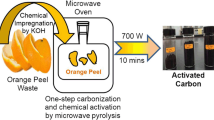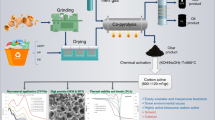Abstract
Activated carbon foam was prepared via direct pyrolysis of waste bread (WB) under CO2 atmosphere. The product was characterized by N2 adsorption/desorption and Fourier transform infrared spectroscopy (FTIR). The preparation process was investigated online by a thermogravimetric analyzer coupled with FTIR (TG-FTIR). The adsorption isotherms of methylene blue (MB) by the product were investigated. The experimental data demonstrated that the product had a high surface area of 1575 m2 g−1 and a total pore volume of 0.883 cm3 g−1. Thermal decomposition of polymers in WB mainly occurred between 200 and 500 °C, leading to the release of carbonyl compounds, aliphatic hydrocarbons, alcohols, and furans. The dominant CO2 activation process started at above 800 °C. The MB adsorption equilibrium data followed Langmuir model with a monolayer adsorption capacity of 403 mg g−1. This study provides a reference for the utilization of WB as a promising precursor of activated carbon foam adsorbent, which has highly porous structure and excellent floatability in water.










Similar content being viewed by others
References
Adessi A, Venturi M, Candeliere F, Galli V, Granchi L, De Philippis R (2018) Bread wastes to energy: sequential lactic and photo-fermentation for hydrogen production. Int J Hydrogen Energ 43:9569–9576
Han W, Hu Y, Li S, Huang J, Nie Q, Zhao H, Tang J (2017) Simultaneous dark fermentative hydrogen and ethanol production from waste bread in a mixed packed tank reactor. J Clean Prod 141:608–611
Melikoglu M, Lin CSK, Webb C (2013) Stepwise optimisation of enzyme production in solid state fermentation of waste bread pieces. Food Bioprod Process 91:638–646
Cerda A, El-Bakry M, Gea T, Sánchez A (2016) Long term enhanced solid-state fermentation: inoculation strategies for amylase production from soy and bread wastes by Thermomyces sp. in a sequential batch operation. J Environ Chem Eng 4:2394–2401
Han W, Huang J, Zhao H, Li Y (2016) Continuous biohydrogen production from waste bread by anaerobic sludge. Bioresour Technol 212:1–5
Han W, Hu YY, Li SY, Li FF, Tang JH (2016) Biohydrogen production from waste bread in a continuous stirred tank reactor: a techno-economic analysis. Bioresour Technol 221:318–323
Benabda O, Kasmi M, Kachouri F, Hamdi M (2018) Valorization of the powdered bread waste hydrolysate as growth medium for baker yeast. Food Bioprod Process 109:1–8
Yu IKM, Tsang DCW, Yip ACK, Chen SS, Wang L, Ok YS, Poon CS (2017) Catalytic valorization of starch-rich food waste into hydroxymethylfurfural (HMF): controlling relative kinetics for high productivity. Bioresour Technol 237:222–230
Yu IKM, Tsang DCW, Chen SS, Wang L, Hunt AJ, Sherwood J, De Oliveira Vigier K, Jerome F, Ok YS, Poon CS (2017) Polar aprotic solvent-water mixture as the medium for catalytic production of hydroxymethylfurfural (HMF) from bread waste. Bioresour Technol 245:456–462
Cao L, Yu IKM, Tsang DCW, Zhang S, Ok YS, Kwon EE, Song H, Poon CS (2018) Phosphoric acid-activated wood biochar for catalytic conversion of starch-rich food waste into glucose and 5-hydroxymethylfurfural. Bioresour Technol 267:242–248
Yang X, Jin D, Zhang M, Wu P, Jin H, Li J, Wang X, Ge H, Wang Z, Lou H (2016) Fabrication and application of magnetic starch-based activated hierarchical porous carbon spheres for the efficient removal of dyes from water. Mater Chem Phys 174:179–186
Pang L, Zou B, Zou Y, Han X, Cao L, Wang W, Guo Y (2016) A new route for the fabrication of corn starch-based porous carbon as electrochemical supercapacitor electrode material. Colloid Surface A 504:26–33
Yang X, Du G, Zhang L, Liu Y (2016) Preparation of hierarchical porous carbon material derived from starch for high-performance electrochemical capacitor. Mater Lett 183:52–55
Yuan Y, Ding Y, Wang C, Xu F, Lin Z, Qin Y, Li Y, Yang M, He X, Peng Q, Li Y (2016) Multifunctional stiff carbon foam derived from bread. ACS Appl Mater Interfaces 8:16852–16861
Yu H, Zhao Y, Yang L, Chen X (2017) Bread-derived carbon foam as an adsorbent for solid-phase microextraction of polybrominated diphenyl ethers. Anal Methods-UK 9:6808–6813
Tian W, Zhang H, Qian Z, Ouyang T, Sun H, Qin J, Tadé MO, Wang S (2018) Bread-making synthesis of hierarchically Co@C nanoarchitecture in heteroatom doped porous carbons for oxidative degradation of emerging contaminants. Appl Catal B-Environ 225:76–83
Chen Y, Li Z, Shi S, Song C, Jiang Z, Cui X (2017) Scalable synthesis of TiO2 crystallites embedded in bread-derived carbon matrix with enhanced lithium storage performance. J Mater Sci-Mater El 28:9206–9220
Tsyntsarski B, Petrova B, Budinova T, Petrov N, Velasco LF, Parra JB, Ania CO (2012) Porosity development during steam activation of carbon foams from chemically modified pitch. Microporous Mesoporous Mater 154:56–61
Lee CG, Jeon JW, Hwang MJ, Ahn KH, Park C, Choi JW, Lee SH (2015) Lead and copper removal from aqueous solutions using carbon foam derived from phenol resin. Chemosphere 130:59–65
Zhou P, Chen Q-L (2016) Preparation and characterization of carbon foam derived from coal pitch. J Anal Appl Pyrolysis 122:370–376
Zhang L, He W, Yang J, Sun J, Li H, Han B, Zhao S, Shi Y, Feng Y, Tang Z, Liu S (2018) Bread-derived 3D macroporous carbon foams as high performance free-standing anode in microbial fuel cells. Biosens Bioelectron 122(217):223. https://doi.org/10.1016/j.bios.2018.09.005
Hao P, Cui G, Shi X, Xie J, Xia X, Sang Y, Wong CP, Liu H, Tang B (2017) High performance supercapacitors from hierarchical porous carbon aerogels based on sliced bread. Chin J Chem 35:699–706
Liu Y, Yan C, Zhang Z, Gong Y, Wang H, Qiu X (2016) A facile method for preparation of floatable and permeable fly ash-based geopolymer block. Mater Lett 185:370–373
Sun Y, Yue Q, Gao B, Li Q, Huang L, Yao F, Xu X (2012) Preparation of activated carbon derived from cotton linter fibers by fused NaOH activation and its application for oxytetracycline (OTC) adsorption. J Colloid Interface Sci 368:521–527
Meng A, Zhou H, Qin L, Zhang Y, Li Q (2013) Quantitative and kinetic TG-FTIR investigation on three kinds of biomass pyrolysis. J Anal Appl Pyrolysis 104:28–37
Worzakowska M, Torres-Garcia E, Grochowicz M (2015) Degradation kinetics of starch-g-poly(phenyl methacrylate) copolymers. Thermochim Acta 619:8–15
Niu S, Zhou Y, Yu H, Lu C, Han K (2017) Investigation on thermal degradation properties of oleic acid and its methyl and ethyl esters through TG-FTIR. Energ Convers Manage 149:495–504
Wang J, Ma X, Yu Z, Peng X, Lin Y (2018) Studies on thermal decomposition behaviors of demineralized low-lipid microalgae by TG-FTIR. Thermochim Acta 660:101–109
Lahijani P, Zainal ZA, Mohammadi M, Mohamed AR (2015) Conversion of the greenhouse gas CO2 to the fuel gas CO via the Boudouard reaction: a review. Renew Sust Energ Rev 41:615–632
Pallarés J, González-Cencerrado A, Arauzo I (2018) Production and characterization of activated carbon from barley straw by physical activation with carbon dioxide and steam. Biomass Bioenergy 115:64–73
Sanders JP, Gallagher PK (2002) Kinetic analyses using simultaneous TG/DSC measurements: part I: decomposition of calcium carbonate in argon. Thermochim Acta 388:115–128
Kwon EE, Lee T, Ok YS, Tsang DCW, Park C, Lee J (2018) Effects of calcium carbonate on pyrolysis of sewage sludge. Energy 153:726–731
Zhou Q, Yan C, Luo W (2016) Polypyrrole coated secondary fly ash–iron composites: novel floatable magnetic adsorbents for the removal of chromium (VI) from wastewater. Mater Design 92:701–709
Zhang F, Wu K, Zhou H, Hu Y, Sergei P, Wu H, Wei C (2018) Ozonation of aqueous phenol catalyzed by biochar produced from sludge obtained in the treatment of coking wastewater. J Environ Manag 224:376–386
Nautiyal P, Subramanian KA, Dastidar MG (2016) Adsorptive removal of dye using biochar derived from residual algae after in-situ transesterification: alternate use of waste of biodiesel industry. J Environ Manag 182:187–197
Li J, Liang N, Jin X, Zhou D, Li H, Wu M, Pan B (2017) The role of ash content on bisphenol A sorption to biochars derived from different agricultural wastes. Chemosphere 171:66–73
Angin D, Altintig E, Kose TE (2013) Influence of process parameters on the surface and chemical properties of activated carbon obtained from biochar by chemical activation. Bioresour Technol 148:542–549
Pezoti Junior O, Cazetta AL, Gomes RC, Barizão ÉO, Souza IPAF, Martins AC, Asefa T, Almeida VC (2014) Synthesis of ZnCl2-activated carbon from macadamia nut endocarp (Macadamia integrifolia) by microwave-assisted pyrolysis: optimization using RSM and methylene blue adsorption. J Anal Appl Pyrolysis 105:166–176
Spagnoli AA, Giannakoudakis DA, Bashkova S (2017) Adsorption of methylene blue on cashew nut shell based carbons activated with zinc chloride: the role of surface and structural parameters. J Mol Liq 229:465–471
Unur E (2013) Functional nanoporous carbons from hydrothermally treated biomass for environmental purification. Microporous Mesoporous Mater 168:92–101
Ahmed MJ, Dhedan SK (2012) Equilibrium isotherms and kinetics modeling of methylene blue adsorption on agricultural wastes-based activated carbons. Fluid Phase Equilib 317:9–14
Wu M, Guo Q, Fu G (2013) Preparation and characteristics of medicinal activated carbon powders by CO2 activation of peanut shells. Powder Technol 247:188–196
Mahamad MN, Zaini MAA, Zakaria ZA (2015) Preparation and characterization of activated carbon from pineapple waste biomass for dye removal. Int Biodeterior Biodegradation 102:274–280
Royer B, Cardoso NF, Lima EC, Vaghetti JC, Simon NM, Calvete T, Veses RC (2009) Applications of Brazilian pine-fruit shell in natural and carbonized forms as adsorbents to removal of methylene blue from aqueous solutions—kinetic and equilibrium study. J Hazard Mater 164:1213–1222
Ip AWM, Barford JP, McKay G (2010) A comparative study on the kinetics and mechanisms of removal of Reactive Black 5 by adsorption onto activated carbons and bone char. Chem Eng J 157:434–442
Acknowledgements
The authors acknowledge the financial support of Fundamental Research Funds for Central Public Welfare Scientific Research Institution (K-JBYWF-2017-T09) and National Key Research and Development Program of China (2016YFE0102400). The authors wish to thank the anonymous reviewers for their useful comments.
Author information
Authors and Affiliations
Corresponding author
Additional information
Publisher’s note
Springer Nature remains neutral with regard to jurisdictional claims in published maps and institutional affiliations.
Rights and permissions
About this article
Cite this article
Cao, J., Gao, Y. & Ma, Y. Facile preparation of activated carbon foam via pyrolysis of waste bread under CO2 atmosphere. Biomass Conv. Bioref. 9, 521–529 (2019). https://doi.org/10.1007/s13399-019-00437-x
Received:
Revised:
Accepted:
Published:
Issue Date:
DOI: https://doi.org/10.1007/s13399-019-00437-x




